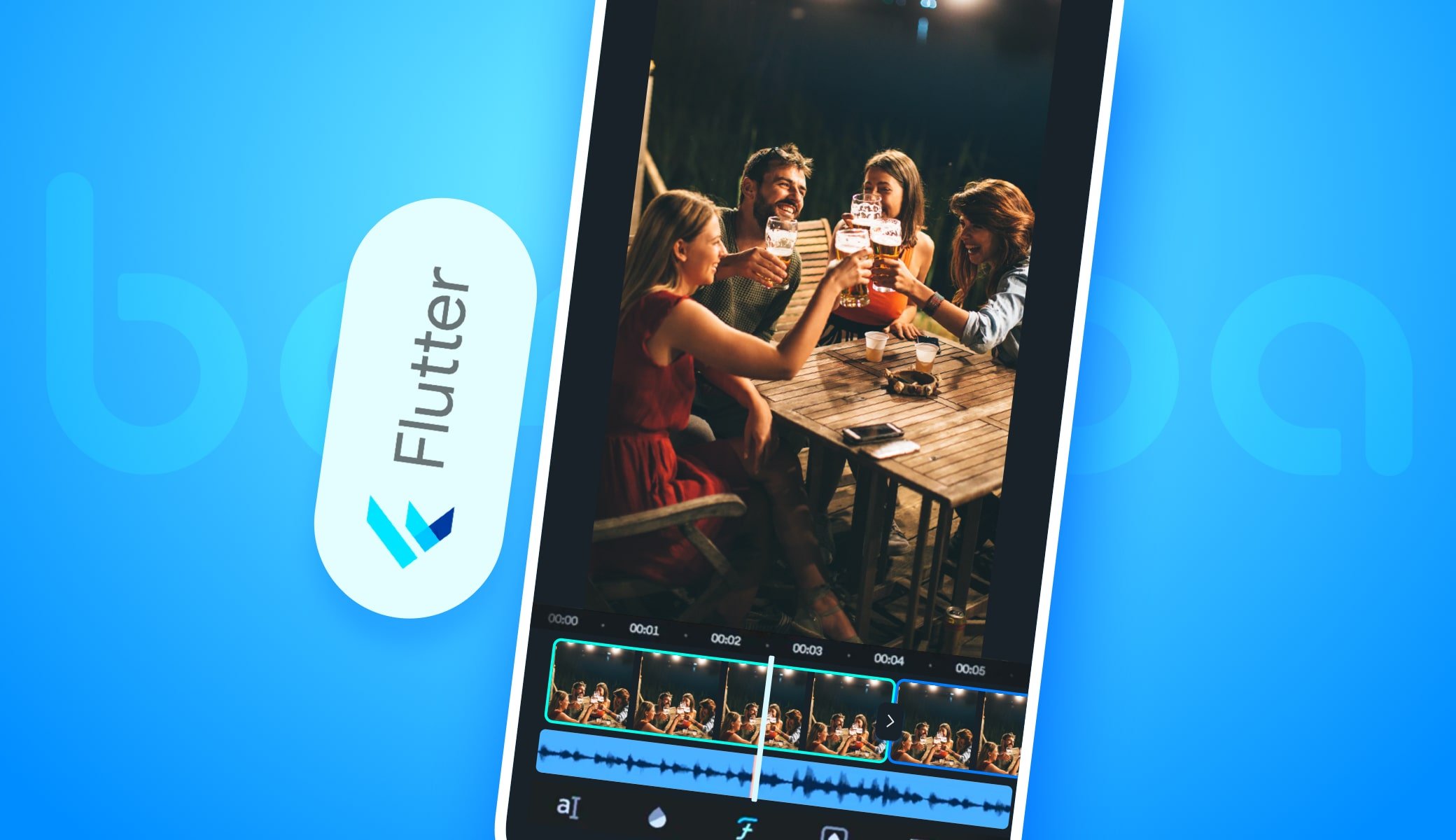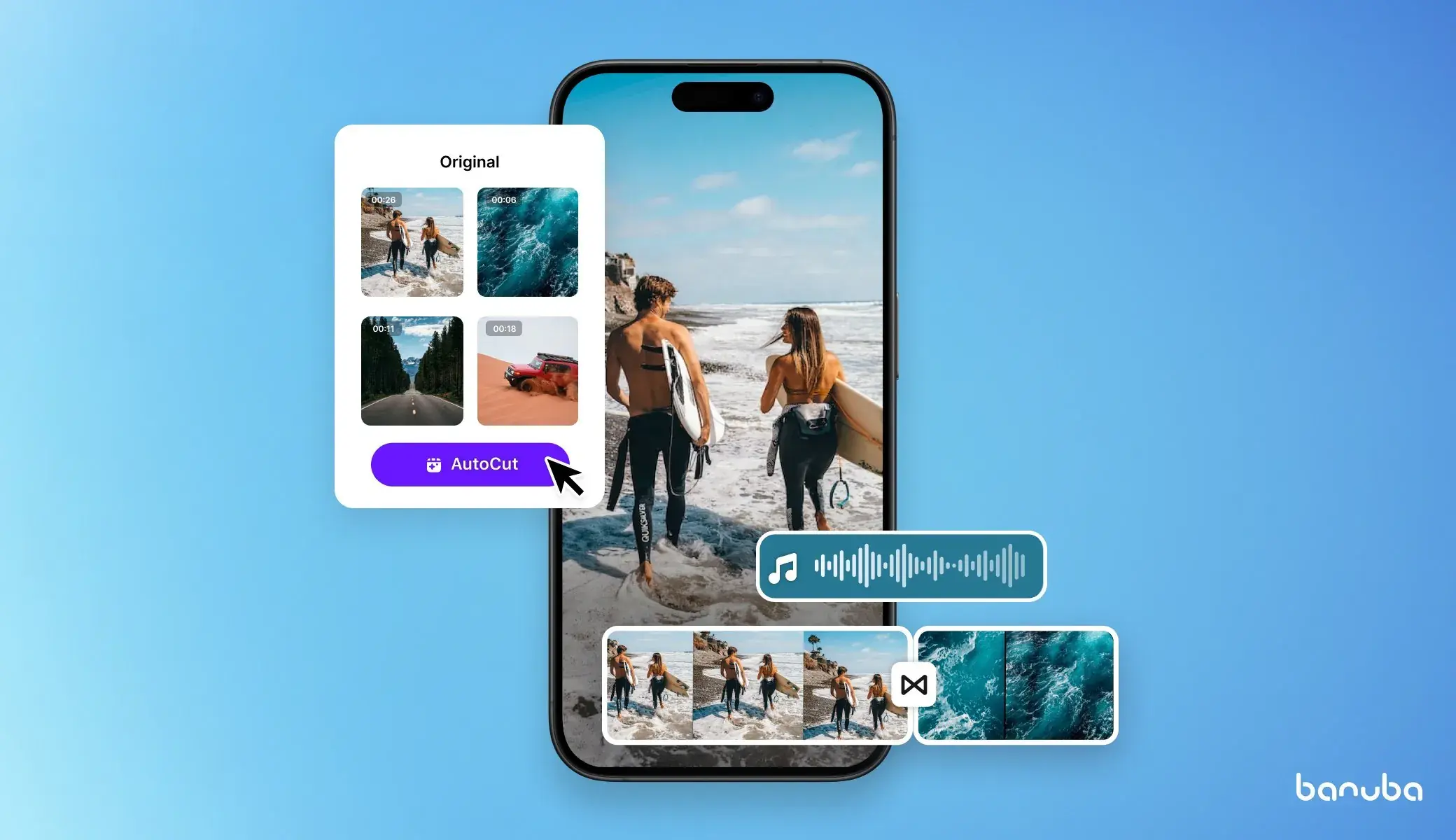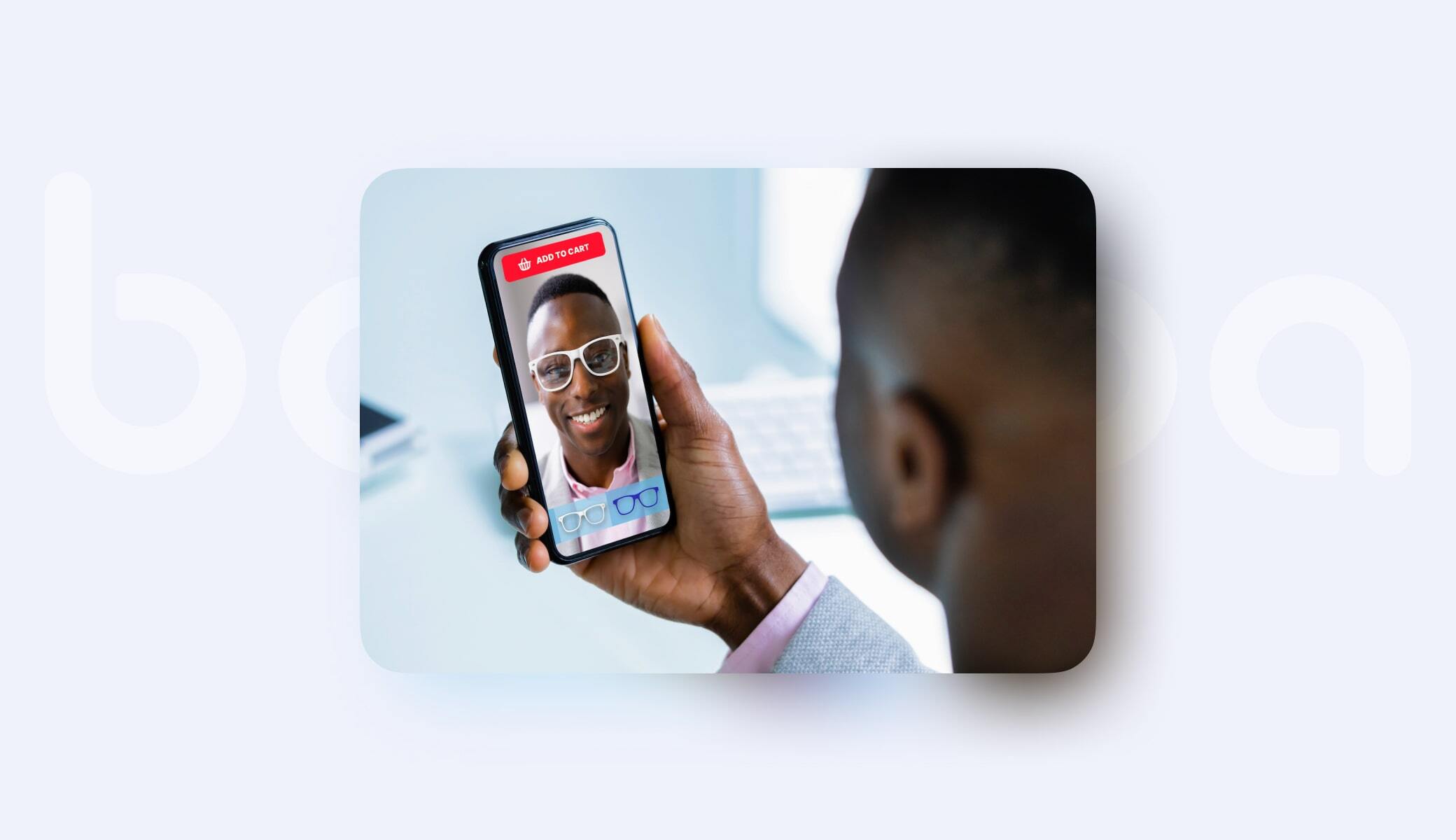[navigation]
TL;DR:
- Flutter developers can use ready-made video editors to speed up release;
- Banuba Video Editor SDK is one of them, offering recording & editing features, as well as AI clipping, auto-generated subtitles and more;
- To integrate it, follow the guide in this article;
- It offers up to 50% decreased development time, as well as increased engagement, polished functionality from start, and a host of other features.
What Is a Video Editor in Flutter?
We’ve all used video editors to cut a few seconds off the start, toss on a filter, add some music, or beyond. And nowadays, more users expect those tools to be built in. The numbers don’t lie, showing that video editing is really booming. With the market poised to hit $4.78B by 2030, growing at 6.19% annually, it’s clear that demand for smart, intuitive editing tools will only keep rising. Driven by increased content creation and mobile-first demand, the video editing app segment is also projected to expand at a 12.5% CAGR from 2026 to 2033, signaling a key growth area within the broader media tech market.
Flutter helps get you there faster. It’s powerful enough to support rich UI components like:
- A scrollable timeline with frame-level precision
- Drag handles for trimming
- Real-time preview playback
- Quick access to filters, music, or stickers
However, the tricky part is that Flutter doesn’t handle media processing or rendering on its own. That’s where tools like Banuba Flutter Video Editor SDK become essential. They take the heavy lifting (exporting, filters, effects, etc.), all allowing you to focus on creating a clean, performant uset experience.
If you’re interested in more tools for handling video in Flutter, feel free to take a look at our list of top Flutter video player libraries. It'll be a solid starting point.
Features of Banuba Video Editor SDK for Flutter
Banuba Flutter Video Editor SDK packs a lot under the hood. Plus, it’s available both as a Flutter plugin and a fully documented sample app, making it easy to integrate into your cross-platform project right away.
“We built the Flutter SDK with developer efficiency in mind. Our goal was to provide a robust, feature-rich solution that feels native to Flutter, so developers can focus on creating unique user experiences rather than wrestling with complex media processing.” - Anton Liskevich, CPO/Co-Founder of Banuba
Let’s break down what it offers.
Recording
Users’ journey starts with the Recording screen. It contains the main controls and allows capturing the footage, setting the timer, etc.

Video tweaking features available on the recording stage:
- Beauty filters
- Color filters (LUTs)
- Music
- Recording speed
- Flashlight
- Timer
- Mute
Video Editing
Users can modify the freshly-recorded footage or select a clip from their library. The editing screen contains video effects, Snapchat-like masks, text, GIF overlays and voice modification features to name but a few.

The timeline makes it easy to organize the add-ons. Whatever the user adds to the video, be that effects, GIF, text or music is shown on the timeline and has its adjustable length.
Video editing features:
- Trimming and concatenation
- Adding music
- Voice changer
- Color filters (LUTs)
- Text and GIF overlays
- TikTok-like video effects
- Slow-mo and speed-up effects
- Snapchat-like masks
- Slide-show from photos
- Splitting
- Aspect ratios
- Editing timeline
- Voice recording
- Royalty-free music library
- Music provider integration
The finished video can be exported or shared.
After editing, the user can export a video file or share it. The format and resolutions vary. You can also add a watermark to your app.
AI clipping
AI clipping makes creating stunning videos easy even for people who never had to edit a single second of footage. Neural networks automatically detect the important parts of several clips, combine them, add transition effects, and match everything to the beat of the music. The user can then enhance the video with more filters, change something, or generate a new video.
This feature raises the amount of user-generated content, as well as session time, engagement, and user retention.
Auto-generated captions
Over 70% of all videos on mobile are watched in silent mode. This means people will likely skip content without subtitles, as turning on the sound is inconvenient. But manually creating captions is tedious and time-consuming. That’s where a speech recognition AI comes in handy. It automatically adds subtitles, and the user can then edit them, as well as change the font size and color.
Background replacement
This feature allows cutting out the person in the video and replacing everything else with a static image, a video, or a GIF. Virtual backgrounds don’t need green screens to work, which makes them convenient and accessible for everyone.
Sample vs Plugin
Banuba offers two distribution options for Video Editor SDK in Flutter: a sample and a video editor Flutter plugin. Both provide the same features. However, there are differences.
Traditionally, Video Editor SDK was distributed as a sample–a demo app with plenty of documentation for all its features. The customer’s developers could modify it however they wanted or add more features. This option is still available and fits the companies that have a team of skilled developers who understand both native and cross-platform coding.
A plugin is the recently added version, available here. It is quick to integrate and lets customers tweak its existing features in various ways. However, adding a new feature requires updating the plugin itself, which can only be done by the original developer team. Customers can send their requests, and eventually these functionality will be added in the standard package.
Plugin works best for companies that don’t need any additional features for their video editor or the ones that don’t have a skilled development team.

How to Integrate Banuba Video Editor SDK in Your Flutter App
1. Check the requirements
Before getting started, check that your development setup and target devices meet these basic requirements.
- For Android:
- Kotlin 2.1 or later / Java 17
- Android OS 8.0 or higher with Camera 2 API
- OpenGL ES 3.0 (or 3.1+ if you're using neural networks on GPU)
- For iOS:
- iOS 15.0 or newer
- Swift 5.9 or newer
- Xcode 16.0 or newer
2. Get a unique token
To start а free trial and integrate the video editor functionality in your app, you need a trial token.
It’s unique to each client and activates all video editor SDK features in your project. To get your token, please, get in touch with us by filling out a form on our website.
3. Add the SDK to your Flutter project
Now that you have your token, install the SDK dependencies.
From your project’s root directory, run:
[code]flutter pub get[/code]
This will fetch the necessary dependencies. After that, you’ll need to set the Banuba license token inside the app—usually during app initialization.
Here’s a simplified example:
[code]// import 'package:banuba_sdk/banuba_sdk.dart'; // Actual import in your code
void main() async {
WidgetsFlutterBinding.ensureInitialized();
await BanubaSDK.initialize('YOUR_UNIQUE_TOKEN');
runApp(MyApp());
}
[/code]
4. Platform-specific configurations
Banuba Flutter Video Editor SDK works across both Android and iOS, but each requires some platform-specific setup.
4.1. Android configuration
Here are a few Android-specific steps you’ll probably need to take:
For the full walkthrough, check out our Android quickstart guide. And feel free to explore the installation guide.
4.2. iOS configuration
-
Navigate to the ios directory within your Flutter project in the terminal:
cd ios
-
Install the necessary CocoaPods dependencies:
pod install
-
Jump into Xcode, find the Signing & Capabilities tab, and select your Development Team. You’ll need this to get the app running on a real iPhone or iPad.
You can also follow our iOS quickstart guide for help getting everything configured smoothly. Or feel free to check out our installation guide.
5. Run the sample application
With dependencies installed and platforms configured, you’re ready to test it out.
Just head to your project root and run:
[code]flutter run[/code]
Or simply launch the app from your IDE.
6. Embed the editor in your app
6.1 Initialize the SDK
To get started, initialize Banuba’s SDK with your license token. This usually happens in main.dart, before the app launches:
[code]// import 'package:banuba_sdk/banuba_sdk.dart';
void main() async {
WidgetsFlutterBinding.ensureInitialized();
await BanubaSDK.initialize('YOUR_UNIQUE_TOKEN');
runApp(MyApp());
}
[/code]
6.2 Add the video editor widget
Next, integrate the editor’s UI into your app. Use BanubaVideoEditorWidget in your widget tree, like so:
[code]class VideoEditorScreen extends StatelessWidget {
@override
Widget build(BuildContext context) {
return Scaffold(
appBar: AppBar(title: Text('Video Editor')),
body: Center(
child: BanubaVideoEditorWidget(),
),
);
}
}
[/code]
This snippet is just a starting point. Check out Banuba’s official GitHub integration sample for a full, working example packed with real-world code.
Recommended Flutter Packages to Complement Your Video Editor
To build a seamless and responsive video editing experience in Flutter, you can combine Banuba Video Editor SDK with other popular packages. These tools can enhance playback, UI flexibility, and state management in your app:
-
video_player
The official Flutter plugin for basic video playback. It’s lightweight and ideal for previewing exported clips or integrating non-editable video views.
-
chewie
A powerful wrapper for video_player that provides custom controls and better styling out of the box.
-
provider or riverpod
Modern state management solutions that help structure your app logic, handle user interactions, and manage editor state across screens and components.
These packages can work in tandem with Banuba’s SDK, depending on your architecture. For example, you might use video_player for simple playback and let Banuba take care of timeline editing, filters, and effects. Together, they create a modular and efficient video editor built for your users.
Flutter Video Editor Example
You open the app, start recording, or pick a video from your device. After that, you’re taken to an editing screen with a simple, scrollable timeline that shows every clip, sound, and effect recently added by you.
You trim the start, cut out a silent moment, and boost the pacing with a quick speed-up effect. Then, you apply a color filter to give your video a crisp, cinematic vibe.
To make it more fun and personal, you overlay animated text and drop in a couple of GIFs. And if you want to go further, then try on an AR mask that reacts to your face in real time, just like on Snapchat.
You finish it off with background music, auto-captions, and a voice effect for flair. When everything’s just right, you export the video with your app’s custom watermark, ready to post or share.
All of this happens smoothly (even on mid-range phones) thanks to Banuba Flutter Video Editor SDK.
Want to see this in action? Check out the official Banuba demo apps on the App Store and Google Play:
These demos show the power and polish your future users can expect.
Benefits of Using Banuba Video Editor SDK in Flutter Apps
Build a powerful video editor into your Flutter app without reinventing the wheel. Banuba Flutter Video Editor SDK helps you deliver TikTok- and Snapchat-style editing experiences with less development effort and faster time to market.

Here’s how it pays off:
Skip building from scratch. Prebuilt UI components for trimming, filters, and exporting let you get your editor live in days, not months.
- Offer a polished, social media-ready experience
Give your users creative freedom with tools made for mobile storytelling: GIFs, text, filters, and more, ready to make every edit social-worthy.
- Keep users engaged longer
Let users play, create, and express themselves. With tons of face AR masks, trigger-based facial animations, fun voice changers, and dynamic effects, there’s always a reason to come back.
- Boost content creation with AI tools
AI-powered tools like auto captions and smart clipping take the pressure off editing, so even beginners can produce more content, more often.
- Deliver pro-level visual quality
From HD clarity to preset color grades and enhanced filters, users get the tools to polish their content like pros—no experience needed.
- Create privacy-focused, dynamic content
Background removal and replacement let users change scenes on the fly (no green screen required). It’s ideal for remote work, education, or storytelling apps.
- Support all major platforms from one codebase
Native performance across Android and iOS with full Flutter and React Native support simplifies your cross-platform strategy.
- Enable hands-free recording and PiP layouts
Useful for tutorials, interviews, or e-commerce product demos, Picture-in-Picture mode and touch-free camera capture support a wide range of use cases.
Reference List
AI SDK for Clipping. Advanced AI video templates SDK for Mobile. (n.d.). https://www.banuba.com/ai-sdk
App Store. (2021, September 8). Banuba video editor. https://apps.apple.com/us/app/banuba-video-editor/id1577338331
Aulas, C. (2025, June 27). 5 Best Facial animation Software in 2025. https://www.banuba.com/blog/best-facial-animation-software
Background changer SDK/API for Photos & Videos. (n.d.). https://www.banuba.com/background-changer-api
Banuba. (n.d.-a). ve-sdk-flutter-integration-sample/lib/main.dart at main · Banuba/ve-sdk-flutter-integration-sample. GitHub. https://github.com/Banuba/ve-sdk-flutter-integration-sample/blob/main/lib/main.dart#L43
Banuba. (n.d.-b). ve-sdk-flutter-integration-sample/mddocs/quickstart_ve_android.md at main · Banuba/ve-sdk-flutter-integration-sample. GitHub. https://github.com/Banuba/ve-sdk-flutter-integration-sample/blob/main/mddocs/quickstart_ve_android.md
Banuba. (n.d.-c). ve-sdk-flutter-integration-sample/mddocs/quickstart_ve_ios.md at main · Banuba/ve-sdk-flutter-integration-sample. GitHub. https://github.com/Banuba/ve-sdk-flutter-integration-sample/blob/main/mddocs/quickstart_ve_ios.md
Banuba Video Editor - Apps on Google Play. (n.d.). https://play.google.com/store/apps/details?id=com.banuba.sdk.ve.demo&hl=en
banuba_sdk | Flutter package. (n.d.). Dart Packages. https://pub.dev/packages/banuba_sdk
Intelligence, M. (2025, July 7). Video Editing Market Size, Share and Growth Research Report 2030. https://www.mordorintelligence.com/industry-reports/video-editing-market#:~:text=The%20global%20video%20editing%20market,first%20creation%20reshape%20competitive%20priorities.
Krasko, A. (2025a, February 3). Top 10 video player Libraries for Flutter. https://www.banuba.com/blog/top-10-video-player-plugins-packages-for-flutter
Krasko, A. (2025b, February 10). Video Editor SDK v1.35.0: AI Captions, ExoPlayer, and FAR 1.11. https://www.banuba.com/blog/video-editor-sdk-v1.35.0-ai-captions-media3-exoplayer-and-far-1.11-support
React Native & Flutter Video Editor SDK. (n.d.). https://www.banuba.com/video-editor-sdk-best-for-developers
Zapier. (2023, March 15). 75% of people watch mobile videos on mute: What that means for advertisers. Digiday. https://digiday.com/sponsored/75-percent-of-people-watch-mobile-videos-on-mute/







